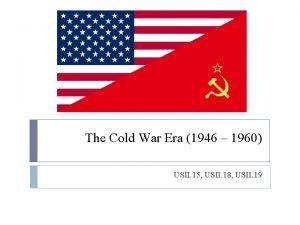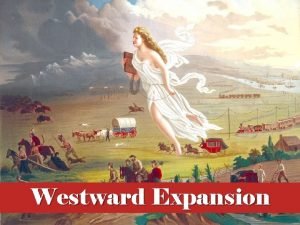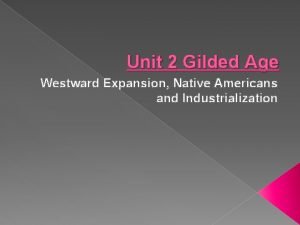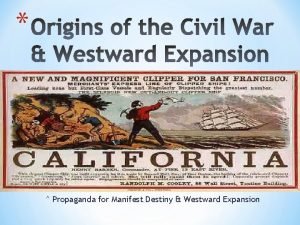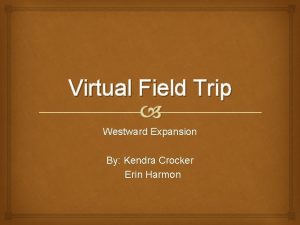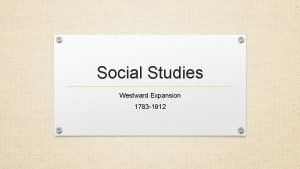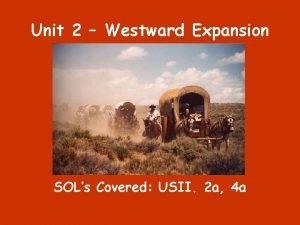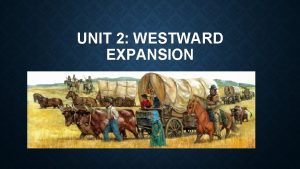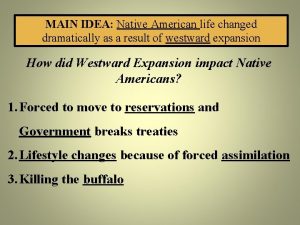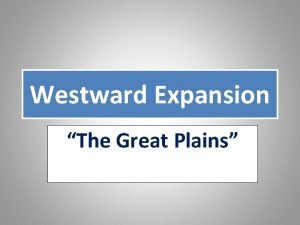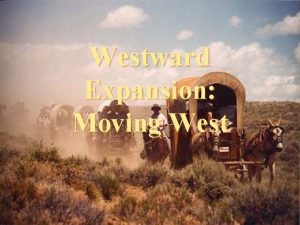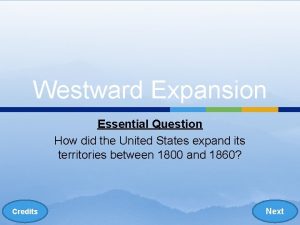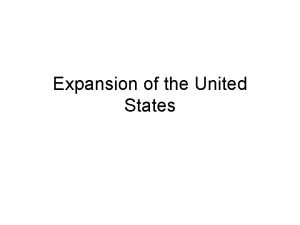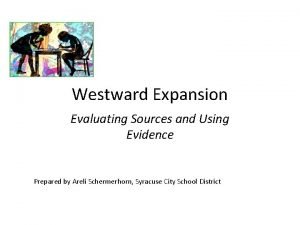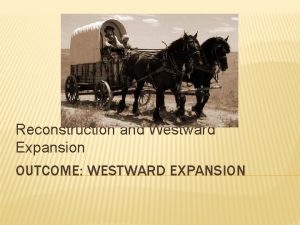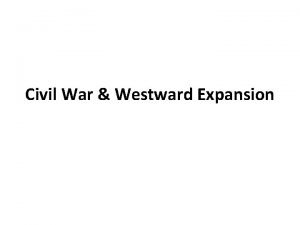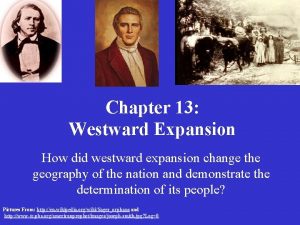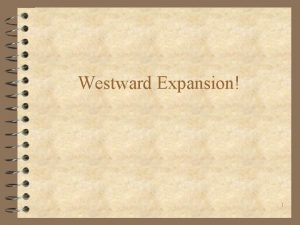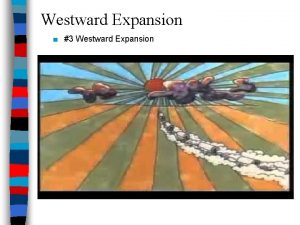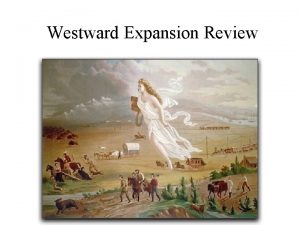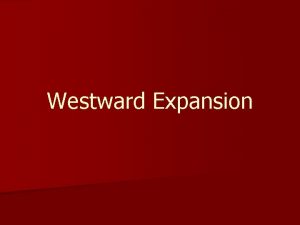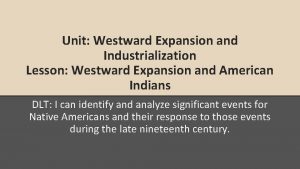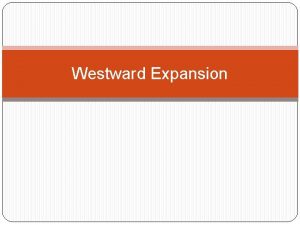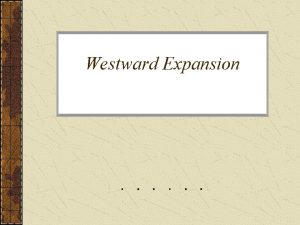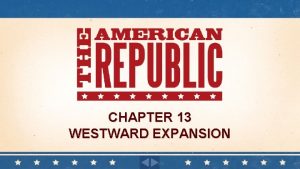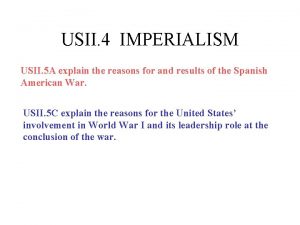Westward Expansion Why Go West USII 3 a





















- Slides: 21

Westward Expansion Why Go West? USII. 3 a

Why did the Western Expansion Occur? • Opportunities for land ownership • The Homestead Act passed in 1862 promising 160 acres of free land to anyone who would farm it for 5 years. 2/13/2022

Why did the Western Expansion Occur? • Adventure

Why did the Western Expansion Occur? • Technological advancestranscontinental railroad

Why did the Western Expansion Occur? • Possibility of wealth created by the discovery of gold and silver. • California Gold Rush • Then later Gold in Alaska

Why did the Western Expansion Occur? • A new beginning former slaves

What were the physical features of the Great Plains? • Flatlands that gradually rise from the east to the west • Land that has been eroded by wind and water • “Treeless Wasteland” • Low rainfall • Frequent dust storms

The Great Plains

The Great Plains – Dust Storms

How did people adapt to life in these challenging environments? • • Barbed Wire Steel plows Dry farming Sod Houses Beef Cattle Raising Wheat Farming Windmills Railroads

Barbed Wire • There was a lack of wood in the west for fences, therefore barbed wire was invented to keep herds of cattle and horse in one place.

Steel Plows • Steel plows were used to irrigate the dry weathered soil of the west.

Dry Farming • Dry farming was used to cultivate drier lands. The soil is plowed deeply to break soil and slow evaporation.

Sod Houses • Without wood settlers looked for other materials to build their homes. Sod houses or “soddies” were built of large bricks of prairie sod.

Beef Cattle Raising • Beef cattle were raised on large areas of open grassland that were unsuitable for growing crops. Thousands of cattle were herded from area to area during the “open range” period on the Great Plains.

Wheat Farming • Farmers began growing crops that were better suited to the drier climate. Wheat is a hardy crop that adapted to the dry growing conditions of the Great Plains.

Windmills • Windmills and mechanical well-drilling machines allowed farmers to get enough water for their families and crops.

Railroads • The government gave railroads free land to develop rail line routes out west. • Towns were established to provide water and other necessities for the rail lines. • Railroads transported settlers and goods to the Great Plains. They provided a means for trade from west to east.

What are some examples of manufacturing areas that were located near centers of population? • New England- Textile Industry • Detroit- Automobile Industry • Pittsburgh- Steel Industry

How did people and goods move from one side of the country to the other? • Railroads and trains • After the Civil War, the US quickly expanded. Railroads were being built to link natural resources, products, and markets. The trains stopped at big cities that were known for manufacturing goods. • Gave many jobs to people after the Civil War.

How did these advances link resources, products, and markets? ~Moving iron ore deposits to sites of steel mills. • Ex: Pittsburgh ~Transporting finished products to national markets. ~Moving natural resources to eastern factories. • Ex: copper and lead, gold, silver
 Political cartoon of the iron curtain
Political cartoon of the iron curtain Westward expansion lewis and clark
Westward expansion lewis and clark Effects of westward expansion
Effects of westward expansion Westward expansion vocabulary words
Westward expansion vocabulary words Westward expansion acrostic poem
Westward expansion acrostic poem Manifest destiny propaganda poster
Manifest destiny propaganda poster Unit 3 rev. statehood and westward expansion
Unit 3 rev. statehood and westward expansion A trip westward question and answer
A trip westward question and answer Horace greeley letter to r.l sanderson
Horace greeley letter to r.l sanderson Jimmy fallon gadsden purchase
Jimmy fallon gadsden purchase Who made it
Who made it Westward expansion wagon
Westward expansion wagon Unit 2 westward expansion vocabulary
Unit 2 westward expansion vocabulary Westward expansion vocabulary
Westward expansion vocabulary Unit 2 westward expansion vocabulary
Unit 2 westward expansion vocabulary Effects of westward expansion
Effects of westward expansion Assimilation westward expansion
Assimilation westward expansion Great plains westward expansion
Great plains westward expansion Westward expansion thesis statement
Westward expansion thesis statement Westward expansion clipart
Westward expansion clipart Westward expansion territories map
Westward expansion territories map Westward expansion
Westward expansion
